Solar batteries for the garden and home: types, principles of operation and procedure for calculating solar systems
Science has given us a time when the technology for using solar energy has become publicly available.Every owner has the opportunity to get solar panels for their home. Summer residents are not lagging behind in this matter. They often find themselves far from centralized sources of sustainable power supply.
We suggest that you familiarize yourself with the information presenting the design, principles of operation and calculation of the working units of the solar system. Familiarization with the information we offer will bring you closer to the reality of providing your site with natural electricity.
For a clear understanding of the provided data, detailed diagrams, illustrations, photo and video instructions are attached.
The content of the article:
- Design and principle of operation of a solar battery
- Types of solar panel modules
- Scheme of solar power supply operation
- Peak load and average daily energy consumption
- The procedure for calculating energy indicators
- Selection of solar power plant components
- Assembly of a household solar system
- Conclusions and useful video on the topic
Design and principle of operation of a solar battery
Once upon a time, inquisitive minds discovered for us natural substances produced under the influence of particles of light from the sun, photons, electrical energy. The process was called the photoelectric effect. Scientists have learned to control microphysical phenomena.
Based on semiconductor materials, they created compact electronic devices - photocells.
Manufacturers have mastered the technology of combining miniature converters into efficient solar panels. The efficiency of silicon solar panel modules widely produced by industry is 18-22%.
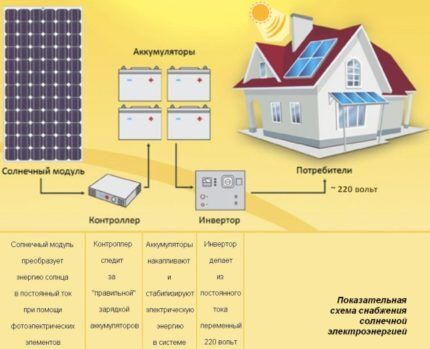
A solar battery is assembled from modules. It is the final point of the journey of photons from the Sun to the Earth. From here, these components of light radiation continue their path inside the electrical circuit as particles of direct current.
They are distributed among batteries, or are transformed into charges of alternating electric current with a voltage of 220 volts, which powers all kinds of home technical devices.

You will find more details about the specifics of the device and the principle of operation of the solar battery in another popular article our site.
Types of solar panel modules
Solar panels-modules are assembled from solar cells, otherwise known as photoelectric converters. FEPs of two types have found widespread use.
They differ in the types of silicon semiconductor used for their manufacture, these are:
- Polycrystalline. These are solar cells made from molten silicon through long-term cooling. The simple production method makes the price affordable, but the productivity of the polycrystalline version does not exceed 12%.
- Monocrystalline. These are elements obtained by cutting an artificially grown silicon crystal into thin wafers. The most productive and expensive option. The average efficiency is around 17%; you can find monocrystalline solar cells with higher performance.
Polycrystalline solar cells are flat square in shape with a non-uniform surface. Monocrystalline varieties look like thin squares with a uniform surface structure with cut corners (pseudosquares).
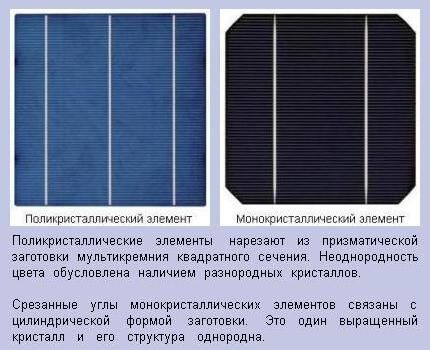
The panels of the first version with the same power are larger than the second ones due to lower efficiency (18% versus 22%). But, on average, they are ten percent cheaper and are in high demand.
You can learn about the rules and nuances of choosing solar panels to supply autonomous heating energy. read here.
Scheme of solar power supply operation
When you look at the mysterious-sounding names of the components that make up the solar light power system, the thought comes to the super-technical complexity of the device.
At the micro level of photon life this is true. And visually, the general diagram of the electrical circuit and the principle of its operation look very simple. There are only four steps from the heavenly body to the “Ilyich light bulb”.
Solar modules are the first component of a power plant. These are thin rectangular panels assembled from a certain number of standard photocell plates. Manufacturers make photo panels of varying electrical power and voltage multiples of 12 volts.
Flat-shaped devices are conveniently located on surfaces open to direct rays. Modular blocks are combined using mutual connections into a solar battery. The battery's task is to convert the received solar energy, producing a direct current of a given value.
Electric charge storage devices - batteries for solar panels known to everyone. Their role within the solar energy supply system is traditional. When household consumers are connected to a centralized network, energy storage devices store electricity.
They also accumulate its excess if the solar module current is sufficient to provide the power consumed by electrical appliances.
The battery pack supplies the required amount of energy to the circuit and maintains a stable voltage as soon as its consumption increases to an increased value. The same thing happens, for example, at night when photo panels are not working or during low-sunny weather.
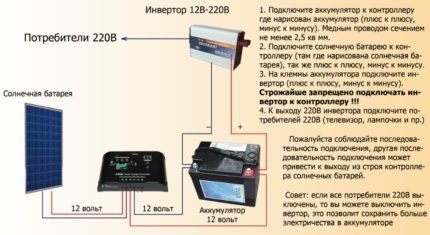
The controller is an electronic intermediary between the solar module and batteries.Its role is to regulate the charge level of the batteries. The device does not allow them to boil due to overcharging or a drop in the electrical potential below a certain norm necessary for stable operation of the entire solar system.
Inverting, this is how the term sounds literally explained solar inverter. Yes, in fact, this unit performs a function that once seemed fantastic to electrical engineers.
It converts the direct current of the solar module and batteries into alternating current with a potential difference of 220 volts. This is the operating voltage for the vast majority of household electrical devices.

Peak load and average daily energy consumption
The pleasure of having your own solar station is still worth a lot. The first step on the path to harnessing the power of solar energy is to determine the optimal peak load in kilowatts and the rational average daily energy consumption in kilowatt-hours for a household or country house.
The peak load is created by the need to turn on several electrical appliances at once and is determined by their maximum total power, taking into account the overestimated starting characteristics of some of them.
Calculating the maximum power consumption allows you to identify which electrical appliances need simultaneous operation and which ones are not so vital. The power characteristics of the power plant components, that is, the total cost of the device, are subject to this indicator.
The daily energy consumption of an electrical appliance is measured by the product of its individual power and the time that it worked from the network (consumed electricity) during the day. The total average daily energy consumption is calculated as the sum of electricity consumed by each consumer over a daily period.
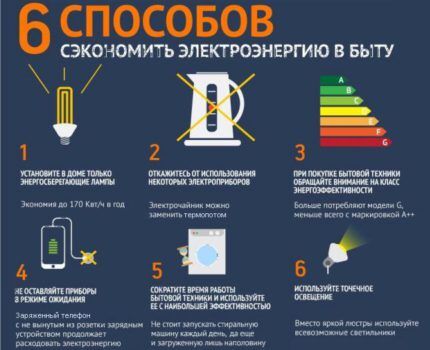
The result of energy consumption helps to rationally approach the consumption of solar electricity. The result of the calculations is important for further calculation of battery capacity. The price of the battery pack, a significant component of the system, depends even more on this parameter.
The procedure for calculating energy indicators
The process of calculations literally begins with a horizontally located, squared, unfolded notebook sheet. With light pencil lines, a form with thirty columns is obtained from the sheet, and lines according to the number of household electrical appliances.
Preparing for Arithmetic Calculations
The first column is traditional - a serial number. The second column is the name of the electrical appliance. The third is its individual power consumption.
Columns four to twenty-seven are the hours of the day from 00 to 24. The following are entered in them through a horizontal fractional line:
- in the numerator – the operating time of the device during a specific hour in decimal form (0.0);
- the denominator is again its individual power consumption (this repetition is needed to calculate hourly loads).
The twenty-eighth column is the total time that the household device operates during the day.In the twenty-ninth - the personal energy consumption of the device is recorded as a result of multiplying the individual power consumption by the operating time over a daily period.
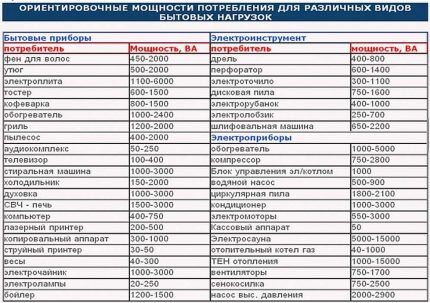
The thirtieth column is also standard - note. It will be useful for intermediate calculations.
Drawing up consumer specifications
The next stage of calculations is the transformation of the notebook form into a specification for household electricity consumers. The first column is clear. The serial numbers of the lines are entered here.
The second column contains the names of energy consumers. It is recommended to start filling the hallway with electrical appliances. The following describes other rooms counterclockwise or clockwise (as is convenient for you).
If there is a second (etc.) floor, the procedure is the same: from the stairs - around. At the same time, we should not forget about devices on stairwells and street lighting.
It is better to fill out the third column indicating the power opposite the name of each electrical device along with the second.
Columns four through twenty-seven correspond to each hour of the day. For convenience, you can immediately draw them out with horizontal lines in the middle of the lines. The resulting upper halves of the lines are like numerators, the lower ones are denominators.
These columns are filled in row by row. Numerators are selectively formatted as time intervals in decimal format (0,0), reflecting the operating time of a given electrical appliance in a particular hourly period. In parallel, where the numerators are entered, the denominators are entered with the indicator of the power of the device, taken from the third column.
After all the hour columns are filled in, proceed to calculating the individual daily working time of electrical appliances, moving line by line. The results are recorded in the corresponding cells of the twenty-eighth column.
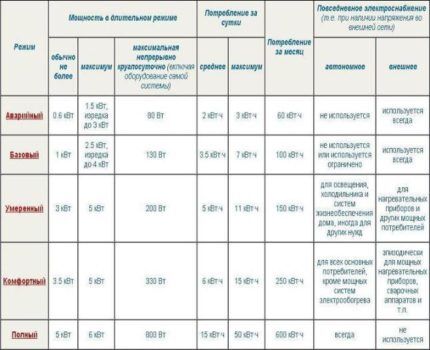
Based on power and working hours, the daily energy consumption of all consumers is sequentially calculated. It is noted in the cells of the twenty-ninth column.
When all the rows and columns of the specification are filled in, the totals are calculated. By adding the power graphs from the denominators of the hour columns, the loads of each hour are obtained. By summing up the individual daily energy consumption of the twenty-ninth column from top to bottom, the total daily average is found.
The calculation does not include the future system's own consumption. This factor is taken into account by the auxiliary coefficient in subsequent final calculations.
Analysis and optimization of obtained data
If power from a solar power plant is planned as a backup, data on hourly power consumption and total average daily energy consumption helps minimize the consumption of expensive solar electricity.
This is achieved by excluding energy-intensive consumers from use until the centralized power supply is restored, especially during peak load hours.
If the solar power system is designed as a source of constant power supply, then the results of hourly loads come forward.It is important to distribute electricity consumption throughout the day in such a way as to eliminate the much predominant highs and very low lows.
Eliminating peak loads, leveling maximum loads, and eliminating sharp dips in energy consumption over time make it possible to select the most economical options for solar system components and ensure stable, and most importantly, trouble-free long-term operation of the solar station.
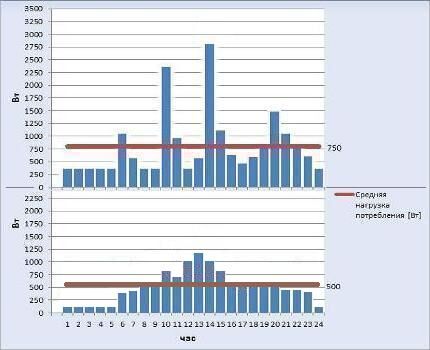
The presented drawing shows the transformation of an irrational schedule obtained on the basis of a specification into an optimal one. The daily consumption rate was reduced from 18 to 12 kW/h, the average daily hourly load from 750 to 500 W.
The same principle of optimality is useful when using the solar power option as a backup. It may not be worth spending too much money on increasing the power of solar modules and batteries for the sake of some temporary inconvenience.
Selection of solar power plant components
To simplify the calculations, we will consider the version of using a solar battery as the main source of electrical energy for the garden. The consumer will be a conditional country house in the Ryazan region, where they permanently reside from March to September.
Practical calculations based on the data from the rational schedule of hourly energy consumption published above will give clarity to the reasoning:
- Total average daily energy consumption = 12,000 watt/hour.
- Average load consumption = 500 watts.
- Maximum load 1200 watts.
- Peak load 1200 x 1.25 = 1500 watts (+25%).
The values will be required in calculating the total capacity of solar devices and other operating parameters.
Determination of the operating voltage of the solar system
The internal operating voltage of any solar system is based on a multiple of 12 volts, which is the most common battery rating. The most widely used components of solar stations: solar modules, controllers, inverters are produced for popular voltages of 12, 24, 48 volts.
A higher voltage allows the use of supply wires of a smaller cross-section - and this means increased contact reliability. On the other hand, failed 12V batteries can be replaced one at a time.
In a 24-volt network, considering the specifics of operating batteries, you will have to replace them only in pairs. A 48V network will require changing all four batteries of one branch. In addition, at 48 volts there is already a danger of electric shock.
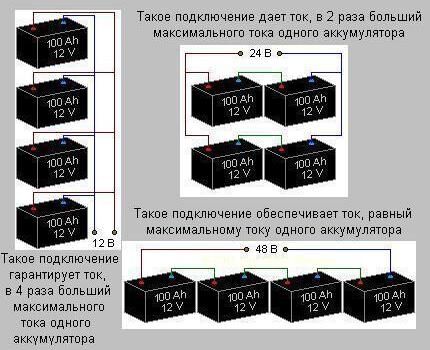
The main choice of the nominal value of the internal potential difference of the system is related to the power characteristics of inverters produced by modern industry and should take into account the magnitude of the peak load:
- from 3 to 6 kW – 48 volts,
- from 1.5 to 3 kW – equal to 24 or 48V,
- up to 1.5 kW – 12, 24, 48V.
Choosing between the reliability of wiring and the inconvenience of replacing batteries, for our example we will focus on reliability. Subsequently, we will start from the operating voltage of the calculated system, 24 volts.
Equipping the battery with solar modules
The formula for calculating the power required from a solar battery looks like this:
Рcm = (1000 * Esut) / (k * Sin),
Where:
- Rcm = solar battery power = total power of solar modules (panels, W),
- 1000 = accepted photovoltaic sensitivity (kW/m²)
- Esut = daily energy consumption requirement (kWh, in our example = 18),
- k = seasonal coefficient taking into account all losses (summer = 0.7; winter = 0.5),
- Syn = tabulated value of insolation (solar radiation flux) at optimal tilt of the panels (kW*h/m²).
You can find out the insolation value from your regional meteorological service.
The optimal angle of inclination of solar panels is equal to the latitude of the area:
- in spring and autumn,
- plus 15 degrees – in winter,
- minus 15 degrees – in summer.
The Ryazan region considered in our example is located at latitude 55.

For the time taken from March to September, the best unregulated tilt of the solar panel is equal to a summer angle of 40⁰ to the surface of the earth. With this installation of modules, the average daily insolation of Ryazan during this period is 4.73. All the numbers are there, let’s do the calculation:
Rcm = 1000 * 12 / (0.7 * 4.73) ≈ 3,600 watts.
If we take 100-watt modules as the basis for the solar battery, then we will need 36 of them. They will weigh 300 kilograms and occupy an area measuring about 5 x 5 m.
Field-tested wiring diagrams and solar panel connection options are given here.
Arrangement of a battery power unit
When choosing batteries, you need to be guided by the following principles:
- Regular car batteries are NOT suitable for this purpose. The batteries of solar power plants are marked with the inscription “SOLAR”.
- You should only purchase batteries that are identical in all respects, preferably from the same factory batch.
- The room where the battery pack is located must be warm. The optimal temperature when the batteries produce full power = 25⁰C. When it drops to -5⁰C, the battery capacity decreases by 50%.
If you take a representative 12-volt battery with a capacity of 100 ampere/hour for calculation, it is easy to calculate that it can provide energy to consumers with a total power of 1200 watts for an entire hour. But this is with complete discharge, which is extremely undesirable.
For long-term battery life, it is NOT recommended to reduce their charge below 70%. Limit figure = 50%. Taking the number 60% as the “golden mean”, we base subsequent calculations on the energy reserve of 720 Wh for every 100 Ah of the capacitive component of the battery (1200 Wh x 60%).
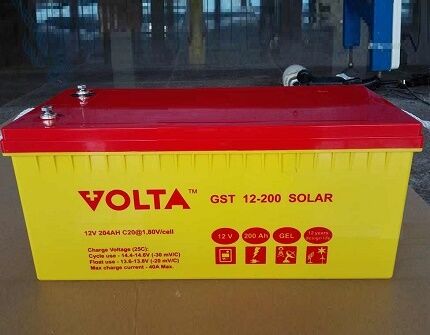
Initially, batteries must be installed 100% charged from a stationary power source. Rechargeable batteries must completely cover the loads in the dark. If you are unlucky with the weather, maintain the required system parameters during the day.
It is important to take into account that an excess of batteries will lead to their constant undercharging. This will significantly reduce the service life. The most rational solution seems to be to equip the unit with batteries with an energy reserve sufficient to cover one daily energy consumption.
To find out the required total battery capacity, divide the total daily energy consumption of 12000 Wh by 720 Wh and multiply by 100 A*h:
12,000 / 720 * 100 = 2500 A*h ≈ 1600 A*h
In total, for our example we will need 16 batteries with a capacity of 100 or 8 of 200 Ah, connected in series-parallel.
Choosing a good controller
Competent selection battery charge controller (AKB) is a very specific task. Its input parameters must correspond to the selected solar modules, and the output voltage must correspond to the internal potential difference of the solar system (in our example, 24 volts).
A good controller must provide:
- Multi-stage battery charging, which multiplies their effective service life.
- Automatic mutual, battery and solar battery connection-disconnection in correlation with charge-discharge.
- Reconnecting the load from the battery to the solar battery and vice versa.
This small unit is a very important component.
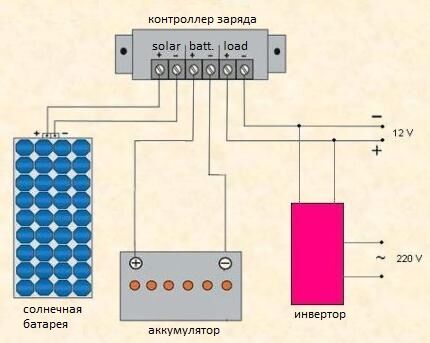
The correct choice of controller determines the trouble-free operation of an expensive battery pack and the balance of the entire system.
Selecting the best inverter
The inverter is selected with such power that it can provide long-term peak load. Its input voltage must correspond to the internal potential difference of the solar system.
For the best selection option, it is recommended to pay attention to the following parameters:
- Shape and frequency of the supplied alternating current. The closer to a sinusoid of 50 hertz, the better.
- Device efficiency. The higher 90%, the more wonderful.
- Own consumption of the device. Must be commensurate with overall system power consumption. Ideally - up to 1%.
- The ability of a node to withstand short-term double overloads.
The most excellent design is an inverter with a built-in controller function.
Assembly of a household solar system
We have made you a photo selection that clearly demonstrates the process of assembling a household solar system from factory-made modules:
Conclusions and useful video on the topic
Video #1. Do-it-yourself demonstration of installing solar panels on the roof of a house:
Video #2. Selection of batteries for a solar system, types, differences:
Video #3. Country solar power plant for those who do everything themselves:
The considered step-by-step practical calculation methods, the basic principle of the effective operation of a modern solar panel battery as part of a home autonomous solar station will help the owners of both a large house in a densely populated area and a country house in the wilderness to gain energy sovereignty.
Would you like to share your personal experience that you gained during the construction of a mini solar system or just batteries? Do you have any questions that you would like answered, or have you found any shortcomings in the text? Please leave comments in the block below.




We have a dacha near Krasnodar. There are enough sunny days, so I decided to experiment and install solar panels. I bought polycrystalline ones. But at first I made a mistake, I incorrectly calculated the number of solar panels, so in June the effect from them was zero. A couple of weeks ago I added more panels, and there is already an effect. Although overall it turned out to be a little expensive. I think it will gradually pay off.
Very informative. It seems to me that questions about the cost of the solar system itself, the price of installation and operation, and, as a consequence, its payback period are modestly ignored. For example, if the system will pay for itself within 15-20 years, is it worth building a garden? During this time, it will itself become dilapidated or become morally obsolete. Maybe, if there is no centralized power supply, just use a generator?
Everything is great! What do you recommend putting on a small dacha? Should I connect the lawnmower to heat the tea? There is no desire to enter into an agreement with the energy system - these are monopolists.
I’ll answer two questions at once: yours and about the payback of the system itself. Firstly, in latitudes where there are many sunny days, the solar system will pay for itself faster than, for example, in Siberia. I know that in the south of Russia the minimum payback period is three years.
Next, a relatively simple installation at the dacha to power the most necessary equipment: there are ready-made solutions, and inexpensive ones, about 350-400 dollars. For example, AXIOMA energy with an indicator of 22/7 kWh per month, summer/winter, to make it clearer. Such a system is quite enough to drink tea, charge your phone and connect a lawn mower.
I'm going to buy a house in the village, and the electricity there is often cut off. I want to protect myself, and this topic is simply very interesting.
How much will it cost to fully provide electricity to a 100 m2 house? Is it possible to ensure 100% autonomy using solar panels?
Well, the most important question is, how will this whole structure perform in the winter? And then you look, they just put everything on the roof and that’s it, the snow probably sticks, and in the spring everything starts to thaw. In general, will all this pay off in theory and what is the average service life?
In general, there are those who have been using it for at least a couple of years? It would be interesting to hear their opinion.
Your questions are quite difficult, but I will try to answer them in order.
Regarding the cost of providing a house of 100 m2. The issue here is not the area but the nominal energy consumption. How do you plan to heat your house? Gas, solid fuel or electric boiler, electric convectors? If it is electric, then in winter the system is unlikely to work. Look, a solar station per kWh will cost 10 thousand dollars. In December there will be the minimum monthly electricity generation rate of up to 429 kWh, the maximum in July - up to 2,142 kWh. With such indicators, you will be able to ensure autonomy in supplying your home with electricity.
Regarding winter and autumn. When nature “rages”, you will have to clean the solar panels from fallen leaves and snow so that productivity does not decrease.
Regarding payback and service life. If you sell surplus to the state during peak months, you can achieve a payback period of approximately 5 years. This is not a specific figure; here you need to calculate based on your monthly consumption, sunny days, current tariffs, etc. Solar panels are now guaranteed for at least ten years, and their degradation rate is only 0.7% per year.